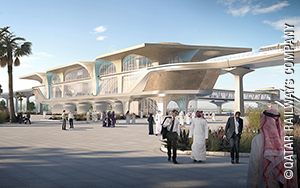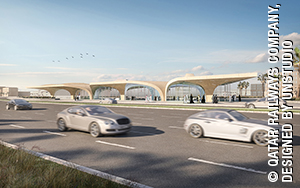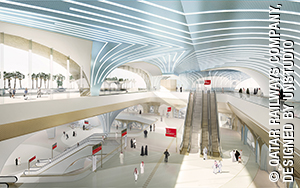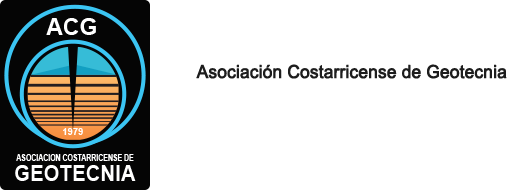Noticias
DIC 23 2014 l Civil Engineering l Catherine A. Cardno, Ph.D.
Significant railway system under way in qatar
 UNStudio, an Amsterdam, the Netherlands-based architecture firm, has been given a rare opportunity to design an entire railway system for a major city. Tasked with creating an overall architectural concept that will unify the 95-plus stations within the four-line Qatar Integrated Railway Project, UNStudio produced a set of architectural guidelines that will be used to create a visually unified system that will nonetheless feature unique and identifiable stations, be they underground, elevated, or at grade. The uniformity of style, elements, and materials used within the new railway system will also serve to lower costs, increase efficiency, and maintain quality for the design and construction of each station. UNStudio, an Amsterdam, the Netherlands-based architecture firm, has been given a rare opportunity to design an entire railway system for a major city. Tasked with creating an overall architectural concept that will unify the 95-plus stations within the four-line Qatar Integrated Railway Project, UNStudio produced a set of architectural guidelines that will be used to create a visually unified system that will nonetheless feature unique and identifiable stations, be they underground, elevated, or at grade. The uniformity of style, elements, and materials used within the new railway system will also serve to lower costs, increase efficiency, and maintain quality for the design and construction of each station.
"One of the challenges with a project of this scale is to create a design which enables both coherence and individuality," said Ben van Berkel, a cofounder and principal architect of UNStudio, who wrote in response to written questions posed by Civil Engineering online. "On the one hand you have to create recognition points across a whole city, while on the other, each individual station has to have its own scale [and] identity, and respond to its specific context."
Amersfoort, Netherlands-based Royal HaskoningDHV, an international engineering consultancy, completed the structural design and mechanical, engineering, and plumbing engineering for the architectural manual.
As it is currently planned, the system will connect the greater Doha area and the communities of Al Khor to the north and Al Wakrah-Mesaieed to the south, according to the architects. While approximately 60 stations are currently planned to be completed in a two-phase process, construction of the first 35 stations are expected to be completed by 2018, and operations are set to begin in 2020, according to the architects.
 The designs contained within UNStudio's Architectural Branding Manual are heavily influenced by the architecture of both the city of Doha and the nation of Qatar, according to van Berkel. While the exteriors of the stations are meant to reference the "monolithic strength of old Qatari architecture," he noted, the interior spaces will honor the nation's strong tradition of "pearling" by creating an "effect of light, movement, and fluidity," both in their architectural designs and in their finishes, which will include materials with an illuminated, mother-of-pearl effect. The designs contained within UNStudio's Architectural Branding Manual are heavily influenced by the architecture of both the city of Doha and the nation of Qatar, according to van Berkel. While the exteriors of the stations are meant to reference the "monolithic strength of old Qatari architecture," he noted, the interior spaces will honor the nation's strong tradition of "pearling" by creating an "effect of light, movement, and fluidity," both in their architectural designs and in their finishes, which will include materials with an illuminated, mother-of-pearl effect.
"On the whole, the stations are designed to represent a vision of both modernization and preservation," van Berkel noted. "We wanted to merge the past and the future of Qatar in one gesture, so we drew inspiration from various traditional Qatari architectural elements-particularly the arch-and adjusted this to create what we refer to as vaulted spaces." These vaulted spaces will repeat within each station, he noted.
The designs also reference the notion of caravanserais , a type of inn with an enclosed court that served as gathering and resting places on ancient trade routes, according to the architects.
Within the stations, interconnected, triangular, base forms are combined to create lines that are inspired by the tensile profiles of nomadic tents and the lightness of the traditional dhow sail, according to the architects.
While the design guidelines for the station's interiors highlight visual lightness, the structural elements had to quite literally support these efforts. "Although by definition a vaulted or arc shape really fits for large spans, it was quite a challenge to locate the load-bearing landing points without causing interference in logistics, aesthetics, fire safety, buildability, et cetera," said Janko Arts, a structural consulting engineer at Royal HaskoningDHV, who was responsible for the technical aspects of the publication. Arts wrote in response to written questions posed by Civil Engineering online.
 Basic engineering solutions for the stations have been specified throughout the guidelines, and vary according to whether the station is to be built above ground, under ground, or at grade, according to Maarten Faber, a senior project manager for infrastructure for Royal HaskoningDHV, who also wrote in response to written questions posed by C i vil Engineering online. This includes the use of concrete with a strength grade of C50/60, as given in European building codes, for the structures' columns. By doing so, relatively slender columns can be used at the platform level, which enables larger open spaces for logistics and passenger transfer, according to Faber. Basic engineering solutions for the stations have been specified throughout the guidelines, and vary according to whether the station is to be built above ground, under ground, or at grade, according to Maarten Faber, a senior project manager for infrastructure for Royal HaskoningDHV, who also wrote in response to written questions posed by C i vil Engineering online. This includes the use of concrete with a strength grade of C50/60, as given in European building codes, for the structures' columns. By doing so, relatively slender columns can be used at the platform level, which enables larger open spaces for logistics and passenger transfer, according to Faber.
The specifications include the use of "monolithic, rather thick slabs on columns while preventing the use of (deep) beams [to] provide maximum flexibility for ducting and architectural shaping," Faber said. Exceptions to this recommendation include locations near the central voids that are left for escalators, where beams are recommended "to achieve a solution which allows for large spans (15 to 20 m) combined with large central voids," he noted.
For underground stations, the rooftop slabs are specified as "prefabricated and prestressed members, allowing for free spans up to 24 m and capable of bearing an overburden and traffic loads," Faber said. In addition, the guidelines require that any future buildings built atop the stations must be founded on the perimeter wall structures rather than on the rooftop slabs, he said.
Large elevated and at-grade shelter structures will be steel with composite cladding because "steel is relatively lightweight and can be molded into almost every thinkable space," Faber explained. "Steel only asks for a minimum of support structure while constructing and can easily be transported to the site in small pieces, which is a major plus considering the densely built inner city of Doha," he said. Smaller shelter structures can be constructed with structural composite only, he noted.
While the design manual will ensure that the network's identity is reflected in the designs of each of the stations, each of the four rail lines within the system-the Historic line, the Coastal line, the City line and the Education line-will be given a different theme. These themes will be repeated inside the stations within each line through distinct wall and floor treatments, as well as through "material applications" that orient and guide the travelers through their journey, according to material provided by the architects.
Individual station identities will be emphasized by interior displays that will enable each station to serve as a cultural vehicle for its specific locale, according to the architects. "By using a large catalogue of architectural elements it became possible to develop a flexible and adaptable new architectural system," van Berkel said. Because design/build contractors will create specific designs based on the guidelines, production and assembly of the structural and architectural elements for the stations will be efficiently organized and overseen, according to van Berkel.
Within the context of the architectural guidelines, site constraints will guide the final design of each station by the design/build contractors. "In this way, we can combine local contextual differences within an overall identity and parametrically adapt physical factors—such as wayfinding, daylight penetration, passenger flows, constructive elements, et cetera—in a complex but extremely disciplined system," van Berkel said.
On-site variations in geologic and geotechnical characteristics will mainly influence the structural engineering of the perimeter station boxes and rail tunnels, which will be designed by the design/build contractors, according to Arts.
Creating a new rail network from scratch provides an opportunity to create a system that encourages people to use public transportation instead of private transportation, according to the architects. The strong visual identity that will be created for the network, and stations will also serve as permanent, visual reminders to people of the network as a viable transportation alternative.
|
VER TODAS
LAS NOTICIAS
 Afiliación Afiliación
 Formularios Formularios
|

 UNStudio, an Amsterdam, the Netherlands-based architecture firm, has been given a rare opportunity to design an entire railway system for a major city. Tasked with creating an overall architectural concept that will unify the 95-plus stations within the four-line Qatar Integrated Railway Project, UNStudio produced a set of architectural guidelines that will be used to create a visually unified system that will nonetheless feature unique and identifiable stations, be they underground, elevated, or at grade. The uniformity of style, elements, and materials used within the new railway system will also serve to lower costs, increase efficiency, and maintain quality for the design and construction of each station.
UNStudio, an Amsterdam, the Netherlands-based architecture firm, has been given a rare opportunity to design an entire railway system for a major city. Tasked with creating an overall architectural concept that will unify the 95-plus stations within the four-line Qatar Integrated Railway Project, UNStudio produced a set of architectural guidelines that will be used to create a visually unified system that will nonetheless feature unique and identifiable stations, be they underground, elevated, or at grade. The uniformity of style, elements, and materials used within the new railway system will also serve to lower costs, increase efficiency, and maintain quality for the design and construction of each station.
 The designs contained within UNStudio's Architectural Branding Manual are heavily influenced by the architecture of both the city of Doha and the nation of Qatar, according to van Berkel. While the exteriors of the stations are meant to reference the "monolithic strength of old Qatari architecture," he noted, the interior spaces will honor the nation's strong tradition of "pearling" by creating an "effect of light, movement, and fluidity," both in their architectural designs and in their finishes, which will include materials with an illuminated, mother-of-pearl effect.
The designs contained within UNStudio's Architectural Branding Manual are heavily influenced by the architecture of both the city of Doha and the nation of Qatar, according to van Berkel. While the exteriors of the stations are meant to reference the "monolithic strength of old Qatari architecture," he noted, the interior spaces will honor the nation's strong tradition of "pearling" by creating an "effect of light, movement, and fluidity," both in their architectural designs and in their finishes, which will include materials with an illuminated, mother-of-pearl effect. Basic engineering solutions for the stations have been specified throughout the guidelines, and vary according to whether the station is to be built above ground, under ground, or at grade, according to Maarten Faber, a senior project manager for infrastructure for Royal HaskoningDHV, who also wrote in response to written questions posed by C i vil Engineering online. This includes the use of concrete with a strength grade of C50/60, as given in European building codes, for the structures' columns. By doing so, relatively slender columns can be used at the platform level, which enables larger open spaces for logistics and passenger transfer, according to Faber.
Basic engineering solutions for the stations have been specified throughout the guidelines, and vary according to whether the station is to be built above ground, under ground, or at grade, according to Maarten Faber, a senior project manager for infrastructure for Royal HaskoningDHV, who also wrote in response to written questions posed by C i vil Engineering online. This includes the use of concrete with a strength grade of C50/60, as given in European building codes, for the structures' columns. By doing so, relatively slender columns can be used at the platform level, which enables larger open spaces for logistics and passenger transfer, according to Faber. 



